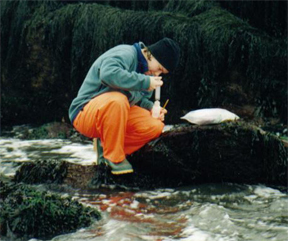Virginia Lehmkuhl
MSc
« Return to Home Page «« Return to Lab Members
 |
Virginia LehmkuhlMSc Research: Phylogeny of the Plocamiales (Rhodophyta) using the LSU gene system & morphological characters.
|
Hi, Some may wonder how someone from the prairies gets into red algal systematics. My story goes something like this: I went out to Bamfield Marine Station and saw real seaweed for the first time in my final year as an undergraduate. Unfortunately, my West Coast B.C stay lasted but six weeks. Painfully, I went back home to Saskatoon, Saskatchewan and decided not to kill myself, but completed an undergraduate NSERC research award in tomato research. The tomatoes didn’t really turn my crank and so I had a mental breakdown. Thoughts of my brief stay at the Bamfield Marine Station, my Phycology class (guided by the infamous Dr. Gary W. Saunders and Dr. Louis Druehl) and the seaweed were my only solace. 50 emails to GAZZA (Gary Saunders), a few doomed applications to NSERC, and a plane ticket east to Fredericton, N.B. and life is “algal.” The meaning of “algal” depends on the day. We are fortunate in that molecular systematics in red algae presents a range of challenges on a daily basis. Tasks span from handling DNA samples that would induce just about anyone to cry out: “There can’t be anything there!!!!!!!!” to hanging out on an exposed cliff that can only be accessed by a Zodiac coast guard boat. It’s all in the name of algae!!!!! But seriously, something about my research… We (Dr. Saunders and myself) are investigating the morphological/anatomical diversity and molecular systematics of the red algal order, Plocamiales, currently containing only two genera. The first genus, Plocamiocolax is parasitic on various species of the second genus, Plocamium. Within these genera, there are a number of issues concerning the relatedness among species that we are currently addressing. A first issue concerns the definition of the type species, Plocamium cartilagineum (Linnaeus) Dixon, 1967. P. cartilagineum is reportedly cosmopolitan in its distribution, however, preliminary molecular investigations indicate that there is substantial genetic divergence among P. cartilagineum isolates from diverse geographic locations. Samples collected from the North Pacific, Chile and Australia appear to be more closely related to respective local species than they are to one another or to P. cartilagineum from the type locality (Europe). This genetic diversity suggests some cryptic species are currently incorrectly included in the P. cartilagineum morphological concept. The second issue that we are addressing is the number of and the relationships among Plocamium species. Plocamium reportedly contains between 20 and 50 species worldwide, however, the current knowledge of species diversity remains insufficient. We are currently conducting a molecular survey of the Plocamiales using the LSU (large ribosomal subunit) gene system that is routinely applied in the laboratories of Dr. Gary Saunders. Molecular data is also being complemented with morphological and anatomical analyses. In the process, we are hoping to shed some light on some of the issues of worldwide species diversity in the order Plocamiales. Virginia |
|